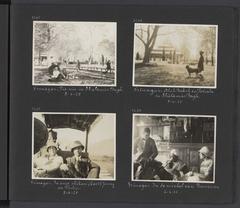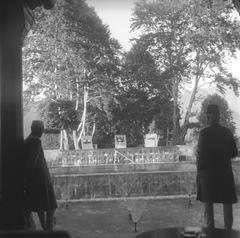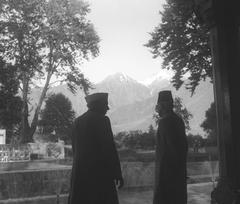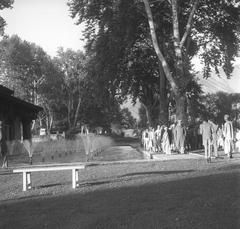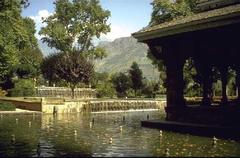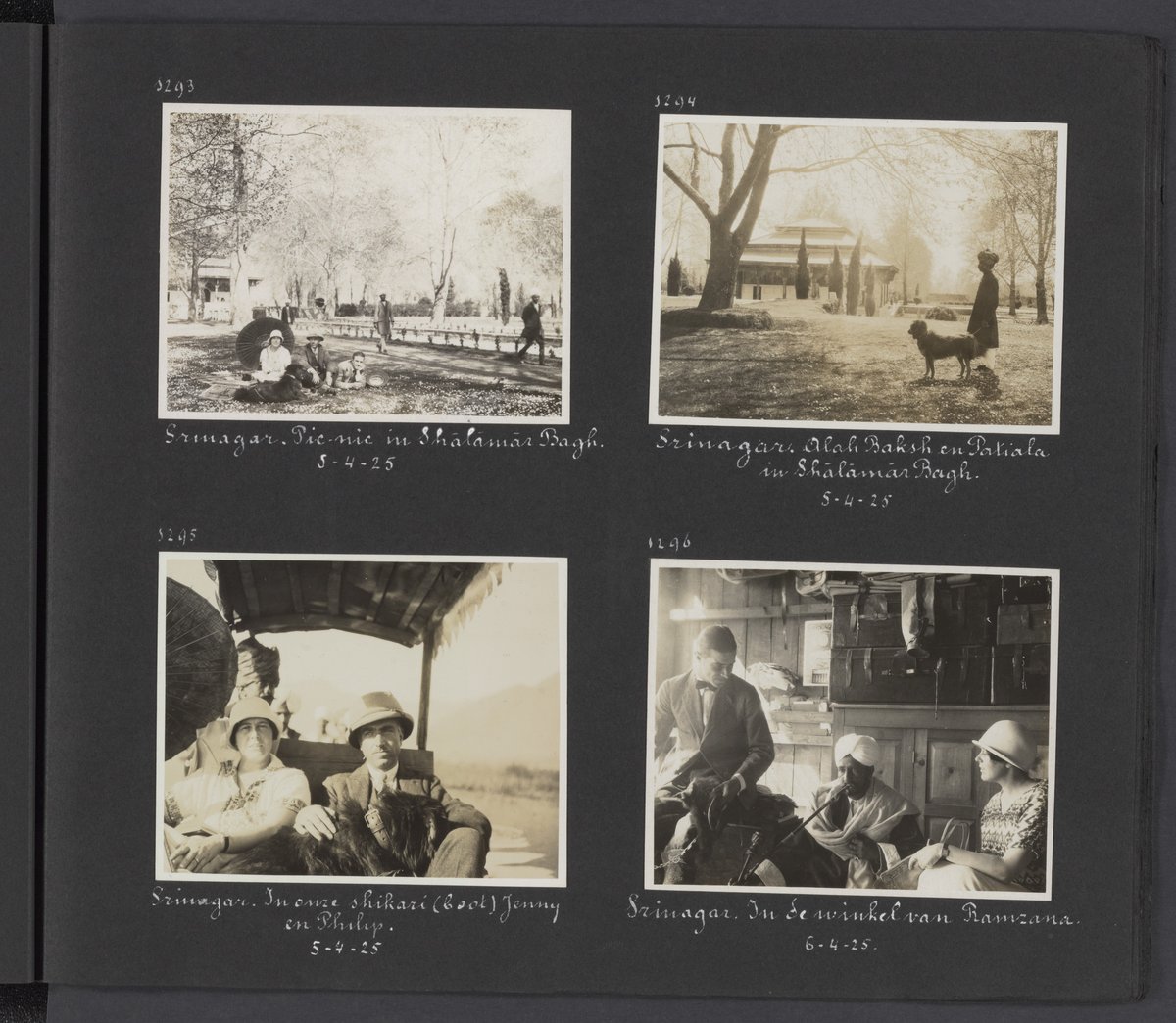
Shalimar Bagh Visiting Hours, Tickets, and Historical Sites in Budgam
Date: 17/07/2024
Introduction
Shalimar Bagh, located in the Budgam district of Jammu and Kashmir, India, stands as a magnificent testament to Mughal horticulture and landscape architecture. Built in 1619 by the Mughal Emperor Jahangir for his beloved wife, Nur Jahan, this garden epitomizes the grandeur and opulence of the Mughal era. The name ‘Shalimar’ is derived from the Sanskrit word ‘Shalimar,’ meaning ‘abode of love,’ reflecting the garden’s historical romantic origins. Shalimar Bagh is renowned for its traditional Charbagh (four-part) layout, symbolizing the Islamic concept of paradise, and is a blend of Persian and Indian design elements (source). Over the centuries, it has not only served as a royal retreat but also as a venue for significant political and diplomatic meetings. Today, Shalimar Bagh is a popular tourist destination, especially beautiful during spring and autumn when flowers bloom, and Chinar trees display vibrant colors. Visitors can explore the garden’s terraces, pavilions, and water features while immersing themselves in the rich history and cultural heritage of the Mughal era (source). This comprehensive guide aims to provide you with all the essential information for an unforgettable visit to Shalimar Bagh, from historical insights and architectural marvels to practical travel tips and nearby attractions.
Table of Contents
- [Introduction](#introductionintroduction)
- [History and Significance of Shalimar Bagh](#history-and-significance-of-shalimar-baghhistory-and-significance-of-shalimar-bagh)
- [Historical Background](#historical-backgroundhistorical-background)
- [Architectural Significance](#architectural-significancearchitectural-significance)
- [Cultural and Historical Significance](#cultural-and-historical-significancecultural-and-historical-significance)
- [Preservation and Restoration](#preservation-and-restorationpreservation-and-restoration)
- [Visitor Experience](#visitor-experiencevisitor-experience)
- [Practical Information](#practical-informationpractical-information)
- [Essential Visitor Tips for Shalimar Bagh](#essential-visitor-tips-for-shalimar-baghessential-visitor-tips-for-shalimar-bagh)
- [Best Time to Visit](#best-time-to-visitbest-time-to-visit)
- [Entry Fees and Timings](#entry-fees-and-timingsentry-fees-and-timings)
- [How to Get There](#how-to-get-therehow-to-get-there)
- [Local Transportation](#local-transportationlocal-transportation)
- [Guided Tours](#guided-toursguided-tours)
- [What to Wear](#what-to-wearwhat-to-wear)
- [Photography Tips](#photography-tipsphotography-tips)
- [Food and Refreshments](#food-and-refreshmentsfood-and-refreshments)
- [Accessibility](#accessibilityaccessibility)
- [Safety Tips](#safety-tipssafety-tips)
- [Nearby Attractions](#nearby-attractionsnearby-attractions)
- [Dal Lake](#dal-lakedal-lake)
- [Nishat Bagh](#nishat-baghnishat-bagh)
- [Hazratbal Shrine](#hazratbal-shrinehazratbal-shrine)
- [Pari Mahal](#pari-mahalpari-mahal)
- [Chashme Shahi](#chashme-shahichashme-shahi)
- [Tulip Garden](#tulip-gardentulip-garden)
- [Conclusion](#conclusionconclusion)
- [FAQ](#faqfaq)
- [References](#referencesreferences)
History and Significance of Shalimar Bagh
Historical Background
Shalimar Bagh dates back to the early 17th century and was commissioned by the Mughal Emperor Jahangir in 1619 for his beloved wife, Nur Jahan. The name “Shalimar” is derived from the Sanskrit word “Shalimar,” meaning “abode of love.” The garden reflects the grandeur and opulence of the Mughal era, serving as a royal retreat for the emperor and his court.
Architectural Significance
Shalimar Bagh is renowned for its exquisite Mughal architecture, combining Persian and Indian design elements. The garden is laid out in the traditional Charbagh (four-part) layout, symbolizing the Islamic concept of paradise. It is divided into three terraces:
- Diwan-i-Aam (Public Audience Hall): The first terrace features a central water channel, Shah Nahar, adorned with fountains and lined with Chinar trees.
- Diwan-i-Khas (Private Audience Hall): Reserved for private gatherings, this terrace includes the Black Pavilion made of black marble and features beautiful Persian calligraphy.
- Zenana (Private Chambers): The most secluded terrace, reserved for the royal family, features lush gardens and pavilions designed for relaxation.
Cultural and Historical Significance
Shalimar Bagh has been a source of inspiration for poets, artists, and writers for centuries. It served as a venue for important political and diplomatic meetings during the Mughal era. The serene and picturesque setting provided the perfect backdrop for discussions and negotiations.
Preservation and Restoration
Over the centuries, Shalimar Bagh has faced numerous challenges, including neglect and natural disasters. The Archaeological Survey of India (ASI) has undertaken several restoration projects to maintain the garden’s architectural integrity. The garden is now included in the tentative list of UNESCO World Heritage Sites, highlighting its global importance.
Visitor Experience
Practical Information
- Visiting Hours: Shalimar Bagh is open from 9 AM to 7 PM daily.
- Tickets: Entry fee is INR 24 for Indian citizens and INR 300 for foreign nationals.
- Accessibility: The garden is wheelchair accessible, with ramps and pathways designed for easy navigation.
- Nearby Attractions: Other historical sites in Budgam include Pari Mahal and Nishat Bagh.
- Travel Tips: Best visited during spring and autumn. Carry water and wear comfortable shoes for walking.
- Special Events: The garden hosts cultural events and festivals, providing an opportunity to experience local traditions.
Essential Visitor Tips for Shalimar Bagh
Best Time to Visit
Shalimar Bagh is best visited during the spring (March to May) and autumn (September to November) seasons. During these periods, the weather is pleasant, and the garden is in full bloom, showcasing a variety of flowers and lush greenery. The average temperature ranges from 15°C to 25°C, making it ideal for leisurely strolls and photography.
Entry Fees and Timings
The garden is open to visitors from 9 AM to 7 PM daily. The entry fee is INR 24 for Indian citizens and INR 300 for foreign tourists. It is advisable to carry cash as card payments may not be accepted at the ticket counter.
How to Get There
By Air
The nearest airport is Sheikh Ul-Alam International Airport in Srinagar, approximately 25 kilometers from Shalimar Bagh. From the airport, you can hire a taxi or use ride-sharing services to reach the garden.
By Train
The closest railway station is Jammu Tawi, about 300 kilometers away. From there, you can take a taxi or a bus to Srinagar and then proceed to Shalimar Bagh.
By Road
Shalimar Bagh is well-connected by road. You can hire a taxi or use local buses from Srinagar. The garden is about 15 kilometers from the city center, and the journey takes around 30 minutes.
Local Transportation
Auto-rickshaws and taxis are readily available for local transportation. It is advisable to negotiate the fare before starting your journey. Alternatively, you can rent a bicycle or a scooter for a more immersive experience.
Guided Tours
For a more informative visit, consider hiring a local guide. Guided tours are available at the entrance and typically cost around INR 200-500. Guides can provide historical insights and interesting anecdotes about the garden.
What to Wear
Comfortable clothing and walking shoes are recommended as you will be spending a considerable amount of time exploring the garden. During the summer months, light cotton clothes are ideal, while in winter, it is advisable to wear layers to keep warm. Don’t forget to carry a hat and sunglasses to protect yourself from the sun.
Photography Tips
Shalimar Bagh is a photographer’s paradise. To capture the best shots, visit early in the morning or late in the afternoon when the light is soft. Tripods are allowed, but drones are prohibited. Always be respectful of other visitors and avoid obstructing pathways.
Food and Refreshments
There are several food stalls and small eateries near the garden entrance where you can enjoy local snacks and beverages. It is advisable to carry bottled water and some light snacks, especially if you plan to spend a few hours exploring the garden.
Accessibility
The garden is partially accessible to visitors with disabilities. While the main pathways are wheelchair-friendly, some areas may have steps or uneven terrain. It is recommended to check with the garden authorities in advance for specific accessibility information.
Safety Tips
- Stay Hydrated: Carry a water bottle, especially during the summer months.
- Sun Protection: Use sunscreen, wear a hat, and carry sunglasses.
- Secure Belongings: Keep your valuables secure and be mindful of pickpockets.
- Emergency Contacts: Note down local emergency contact numbers and the nearest hospital location.
Nearby Attractions
Dal Lake
Located just 10 kilometers from Shalimar Bagh, Dal Lake is a must-visit. You can enjoy a shikara ride or stay in a houseboat for a unique experience (Dal Lake).
Nishat Bagh
Another beautiful Mughal garden, Nishat Bagh, is located about 5 kilometers from Shalimar Bagh. It offers stunning views of the Dal Lake and the surrounding mountains (Nishat Bagh).
Hazratbal Shrine
Situated approximately 8 kilometers from Shalimar Bagh, the Hazratbal Shrine is an important religious site and offers a peaceful retreat (Hazratbal Shrine).
Pari Mahal
Perched on the Zabarwan Mountain range, Pari Mahal, also known as the “Palace of Fairies,” offers panoramic views of Dal Lake and the city of Srinagar. The seven-terraced garden, with its arched niches and stone walls, is a fine example of Mughal architecture (Pari Mahal).
Chashme Shahi
Chashme Shahi, or the “Royal Spring,” is famous for its natural spring, believed to have medicinal properties. The garden’s terraced layout offers a picturesque setting (Chashme Shahi).
Tulip Garden
The Indira Gandhi Memorial Tulip Garden, located at the foothills of the Zabarwan Mountains, is the largest tulip garden in Asia. Spread over 30 hectares, the garden boasts over 1.5 million tulips of various colors and varieties. The annual Tulip Festival, held in April, attracts thousands of visitors (Tulip Garden).
Conclusion
Visiting Shalimar Bagh offers a unique opportunity to step back in time and experience the rich cultural heritage and natural beauty of the Mughal era. From its meticulously designed terraces and pavilions to its vibrant gardens and water features, Shalimar Bagh is a living testament to the grandeur of Mughal landscape architecture. The surrounding attractions, such as Dal Lake, Nishat Bagh, and the Hazratbal Shrine, further enrich the visitor experience, providing a holistic view of the region’s historical and cultural landscape (source). Whether you are a history enthusiast, a nature lover, or simply looking for a peaceful retreat, Shalimar Bagh and its nearby attractions offer something for everyone. Plan your visit during the spring or autumn seasons to witness the garden in its full glory, and don’t forget to explore the local cuisine and cultural events that add to the charm of this historical gem (source). By following the practical tips and information provided in this guide, you can ensure a memorable and enriching experience at Shalimar Bagh, Budgam, India. Follow us on social media and stay updated for more insights and travel tips on historical sites.
FAQ
What are the visiting hours for Shalimar Bagh?
Shalimar Bagh is open from 9 AM to 7 PM daily.
How much are the tickets?
Entry fee is INR 24 for Indian citizens and INR 300 for foreign nationals.
Is Shalimar Bagh wheelchair accessible?
Yes, the garden is wheelchair accessible.
What are some nearby attractions?
Other historical sites in Budgam include Pari Mahal and Nishat Bagh.
References
- Shalimar Bagh, garden, India. Britannica. Shalimar Bagh
- Shalimar Bagh, Srinagar. Lonely Planet. Shalimar Bagh
- Chashme Shahi, garden, Srinagar. Lonely Planet. Chashme Shahi
- Cultural India, Sufi Music. Cultural India
- Hazratbal Shrine, mosque, Srinagar. Britannica. Hazratbal Shrine
- Indira Gandhi Memorial Tulip Garden. Lonely Planet. Tulip Garden
- Nishat Bagh, garden, India. Britannica. Nishat Bagh
- Pari Mahal, palace, Srinagar. Lonely Planet. Pari Mahal
